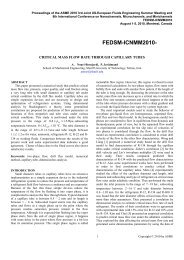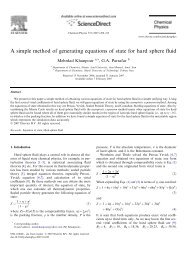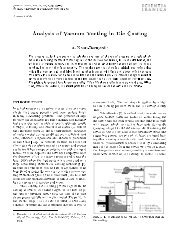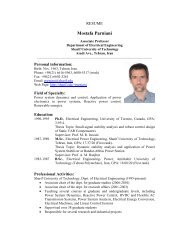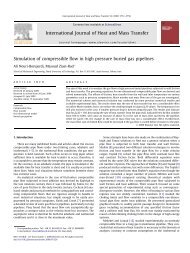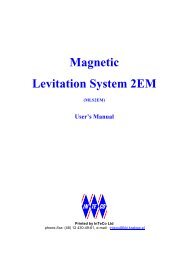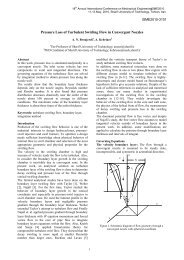The O(n) Model in the n â 0 Limit ( self-avoiding-walks) and ...
The O(n) Model in the n â 0 Limit ( self-avoiding-walks) and ...
The O(n) Model in the n â 0 Limit ( self-avoiding-walks) and ...
You also want an ePaper? Increase the reach of your titles
YUMPU automatically turns print PDFs into web optimized ePapers that Google loves.
<strong>The</strong> O(n) <strong>Model</strong> <strong>in</strong> <strong>the</strong> n → 0 <strong>Limit</strong> ( <strong>self</strong>-avoid<strong>in</strong>g-<strong>walks</strong>)<br />
<strong>and</strong><br />
Logarithmic Conformal Field <strong>The</strong>ory<br />
M. Sadegh Movahed, 1 M. Saadat, 1 <strong>and</strong> M. Reza Rahimi Tabar 1, 2<br />
1 Department of Physics, Sharif University of Technology, P.O.Box 11365–9161, Tehran, Iran<br />
2 CNRS UMR 6529, Observatoire de la Côte d’Azur, BP 4229, 06304 Nice Cedex 4, France<br />
(Dated: November 11, 2004)<br />
Abstract<br />
We consider <strong>the</strong> O(n) <strong>the</strong>ory <strong>in</strong> <strong>the</strong> n → 0 limit. We show that <strong>the</strong> <strong>the</strong>ory is described by<br />
logarithmic conformal field <strong>the</strong>ory, <strong>and</strong> that <strong>the</strong> correlation functions have logarithmic s<strong>in</strong>gularities.<br />
<strong>The</strong> explicit forms of <strong>the</strong> two-, three- <strong>and</strong> four-po<strong>in</strong>t correlation functions of <strong>the</strong> scal<strong>in</strong>g fields <strong>and</strong><br />
<strong>the</strong> correspond<strong>in</strong>g logarithmic partners are derived.<br />
PACS numbers: 05.70.jk;11.25.Hf;64.60.Ak;82.35.Lr
2<br />
I. INTRODUCTION<br />
<strong>The</strong> n-vector model with its L<strong>and</strong>au-G<strong>in</strong>zburg-Willson Hamiltonian, which has O(n) symmetry, may be used to<br />
study physical properties of many critical systems. For example, <strong>in</strong> <strong>the</strong> limit n = 1 we obta<strong>in</strong> Is<strong>in</strong>g-like systems<br />
which describe liquid-vapour transitions <strong>in</strong> <strong>the</strong> classical <strong>and</strong> critical b<strong>in</strong>ary fluids. <strong>The</strong> Helium superfluid transition<br />
corresponds to <strong>the</strong> limit n = 2. Only for <strong>the</strong> case of n = 3 does <strong>the</strong> experimental <strong>in</strong>formation come from truly<br />
ferromagnetic systems. <strong>The</strong> limit n → 0 describes <strong>the</strong> statistical properties of <strong>self</strong>-avoid<strong>in</strong>g <strong>walks</strong> (SAWs), which<br />
describe <strong>the</strong> universal properties of l<strong>in</strong>ear polymers, i.e., long non<strong>in</strong>tersect<strong>in</strong>g cha<strong>in</strong>s, <strong>in</strong> a dilute solution. <strong>The</strong>se<br />
properties can be computed by such techniques as <strong>the</strong> transfer-matrix method [1], series expansions [2], <strong>and</strong> <strong>the</strong><br />
scann<strong>in</strong>g Monte Carlo method [3]. More generally, deep <strong>in</strong>sight <strong>in</strong>to <strong>the</strong> problem of comput<strong>in</strong>g <strong>the</strong> statistical properties<br />
of l<strong>in</strong>ear polymers <strong>and</strong> <strong>the</strong> SAWs can be obta<strong>in</strong>ed from <strong>the</strong> O(n) model <strong>in</strong> <strong>the</strong> n → 0 limit, a discovery first made by<br />
de Gennes [4, 5].<br />
Recently, it has been shown by Cardy that <strong>the</strong> O(n) model <strong>in</strong> <strong>the</strong> n → 0 limit has a logarithmic conformal field<br />
structure, with its correlation function hav<strong>in</strong>g logarithmic s<strong>in</strong>gularity [7]. <strong>The</strong> logarithmic conformal field <strong>the</strong>ories<br />
(LCFT) [6,7] are extensions of <strong>the</strong> conventional conformal field <strong>the</strong>ories (CFT) [8-12], which have emerged <strong>in</strong> recent<br />
years <strong>in</strong> a number of <strong>in</strong>terest<strong>in</strong>g physical problems, such as <strong>the</strong> WZNW models [13-18], supergroups <strong>and</strong> supersymmetric<br />
field <strong>the</strong>ories [19-25], Haldane-Rezzayi state <strong>in</strong> <strong>the</strong> fractional quantum Hall effect [26-30], multi-fractality<br />
[31], two-dimensional turbulence [32-34], gravitaitionally-dressed <strong>the</strong>ories [35], polymer <strong>and</strong> abelian s<strong>and</strong>piles [36-<br />
40], str<strong>in</strong>g <strong>the</strong>ory [41-44] <strong>and</strong> <strong>the</strong> D-brane recoil [45-55], Ads/CFT correspondence [56-67], Seiberg-Witten solution<br />
to SUSY Yang-Mills <strong>the</strong>ory [68] <strong>and</strong> disordered systems [69-80]. Moreover, such related issues as <strong>the</strong> Null vectors,<br />
Characters, partition functions, fusion rules, Modular Invariance, C-<strong>the</strong>orem, LCFT‘s with boundary <strong>and</strong> operator<br />
product expansions have been discussed <strong>in</strong> Refs. [81-119].<br />
<strong>The</strong> LCFT are characterized by <strong>the</strong> fact that <strong>the</strong>ir dilatation operators L 0 are not diagonalized <strong>and</strong> admit a Jordan<br />
cell structure. <strong>The</strong> non-trivial mix<strong>in</strong>g between <strong>the</strong>se operators leads to logarithmic s<strong>in</strong>gularities <strong>in</strong> <strong>the</strong>ir correlation<br />
functions. It has been shown <strong>in</strong> Ref. [8] that <strong>the</strong> correlator of two fields <strong>in</strong> such field <strong>the</strong>ories has a logarithmic<br />
s<strong>in</strong>gularity as follows:<br />
〈ψ(r 1 )ψ(r 2 )〉 ∼ |r 1 − r 2 | −2∆ ψ<br />
ln |r 1 − r 2 | + . . . (1)<br />
In this paper, we consider <strong>the</strong> correlation functions of <strong>the</strong> scal<strong>in</strong>g fields of <strong>the</strong> O(n) model <strong>and</strong> derive explicit<br />
expressions for <strong>the</strong> two-, three- <strong>and</strong> four-po<strong>in</strong>t correlation functions. In Section 2, we derive <strong>the</strong> scal<strong>in</strong>g fields <strong>and</strong><br />
<strong>the</strong>ir scal<strong>in</strong>g exponents. In Section 3, we derive <strong>the</strong> Jordan cell structure of <strong>the</strong> <strong>the</strong>ory <strong>in</strong> <strong>the</strong> n → 0 limit, while<br />
Section 4 presents <strong>the</strong> derivation of <strong>the</strong> two-, three- <strong>and</strong> four-po<strong>in</strong>t correlation functions of <strong>the</strong> scal<strong>in</strong>g fields <strong>and</strong> <strong>the</strong>ir<br />
logarithmic partners. <strong>The</strong> details of calculations are presented <strong>in</strong> <strong>the</strong> Appendices.<br />
II.<br />
SCALING FIELDS IN THE O(n) MODEL<br />
<strong>The</strong> L<strong>and</strong>au-G<strong>in</strong>zburg description of <strong>the</strong> O(n) model starts with <strong>the</strong> effective Hamiltonian:<br />
∫ 1 ∑<br />
H = : [(∇φ a ) 2 + m 2 φ 2<br />
2<br />
a] : +g ∑ : φ 2 aφ 2 b : d d r, (2)<br />
a<br />
a,b<br />
where a, b = 1, 2, · · · , n, <strong>and</strong> g is <strong>the</strong> coupl<strong>in</strong>g constant of <strong>the</strong> perturbation, ∑ a,b : φ2 aφ 2 b<br />
:, to <strong>the</strong> free model. Suppose<br />
that under a scal<strong>in</strong>g transformation ⃗r → ⃗ ŕ = λ⃗r, φ a behaves as, φ a → ´φ a = λ −x0 φa φ a , where x 0 φ a<br />
is called <strong>the</strong> scal<strong>in</strong>g<br />
dimension of <strong>the</strong> field φ a . Invariance of <strong>the</strong> Hamiltonian under scal<strong>in</strong>g requires <strong>the</strong> coupl<strong>in</strong>g g to have <strong>the</strong> scal<strong>in</strong>g<br />
dimension, y g = d − 4x 0 φ a<br />
. It would be relevant at <strong>the</strong> pure fixed po<strong>in</strong>t if, d > 4x 0 φ a<br />
[120-121]. If y g is small, it is<br />
possible to develop a perturbative renormalization group (RG) equation <strong>in</strong> powers of <strong>the</strong>se variables, which can <strong>the</strong>n<br />
yield <strong>the</strong> fixed po<strong>in</strong>ts.<br />
To develop <strong>the</strong> RG equation for a typical coupl<strong>in</strong>g constant g i , we need <strong>the</strong> operator product expansion (OPE)<br />
coefficients. <strong>The</strong> general form of <strong>the</strong> beta-function for coupl<strong>in</strong>g g i is given by [6]:<br />
β gi<br />
≡ dg i<br />
dl<br />
= y gi g i − ∑ jk<br />
C ijk g j g k + · · · , (3)
where l > 1 is a re-scal<strong>in</strong>g parameter. ∫ To derive <strong>the</strong> OPE coefficients we note that, when m 2 = g = 0, we obta<strong>in</strong> <strong>the</strong><br />
Gaussian model, i.e., H = 1 ∑<br />
2 a : (∇φ a) 2 : d d r. In <strong>the</strong> Gaussian model, <strong>the</strong> various components φ a are decoupled,<br />
so that <strong>the</strong> two-po<strong>in</strong>t correlation function has <strong>the</strong> follow<strong>in</strong>g form:<br />
〈φ a (r i )φ b (r j )〉 = δ ab<br />
r d−2<br />
ij<br />
, (4)<br />
where, r ij = |⃗r i −⃗r j |. Consider<strong>in</strong>g Φ = ∑ a,b : φ2 aφ 2 b<br />
: as <strong>the</strong> perturbative term <strong>in</strong> O(n) Hamiltonian, <strong>and</strong> us<strong>in</strong>g Wick’s<br />
<strong>the</strong>orem, one can evaluate <strong>the</strong> OPE of <strong>the</strong> field Φ with it<strong>self</strong> as:<br />
3<br />
Φ · Φ = ( ∑ a,b<br />
: φ 2 aφ 2 b :) · ( ∑ c,d<br />
: φ 2 cφ 2 d :),<br />
= 24n 2 + 96nE + ξ Φ Φ + · · · , (5)<br />
where, E = ∑ c : φ2 c :, n = ∑ ab δ ab <strong>and</strong> ξ Φ = (8n + 64) (see Appendix A). <strong>The</strong>refore, us<strong>in</strong>g Eq.(3), one obta<strong>in</strong>s <strong>the</strong><br />
follow<strong>in</strong>g RG equation for g:<br />
β g = y g g − ξ Φ g 2 + · · · . (6)<br />
To check that <strong>the</strong> field E is a scal<strong>in</strong>g operator, we consider <strong>the</strong> OPE of E with a scal<strong>in</strong>g dimension x E (n) <strong>and</strong> Φ:<br />
E · Φ = ( ∑ c<br />
: φ 2 c :).( ∑ a,b<br />
: φ 2 aφ 2 b :),<br />
= 8Φ + ξ E E + · · · , (7)<br />
where, ξ E = (4n + 8). <strong>The</strong>refore, this form of <strong>the</strong> OPE for E · Φ shows that <strong>the</strong> field E is a scal<strong>in</strong>g operator.<br />
As noted by Cardy [7], <strong>the</strong>re is also ano<strong>the</strong>r scal<strong>in</strong>g field <strong>in</strong> <strong>the</strong> <strong>the</strong>ory, Ẽab, with a scal<strong>in</strong>g dimension xẼ(n) which<br />
is given explicitly by <strong>the</strong> follow<strong>in</strong>g expression <strong>in</strong> terms of <strong>the</strong> fields φ a : Ẽ ab =: φ a φ b : − δ ∑<br />
ab<br />
n c : φ2 c :. Its OPE with Φ<br />
is given by <strong>the</strong> follow<strong>in</strong>g expression:<br />
Ẽ ab .Φ = (: φ a φ b : − δ ab<br />
n<br />
∑<br />
: φ 2 c :).( ∑ : φ 2 dφ 2 e :),<br />
c<br />
d,e<br />
= − 8 n δ abΦ + ξẼẼ ab + · · · , (8)<br />
with ξẼ = 8.<br />
To derive <strong>the</strong> scal<strong>in</strong>g dimensions of <strong>the</strong> fields E <strong>and</strong> Ẽab, we perturb <strong>the</strong> Gaussian Hamiltonian by <strong>the</strong>se fields with<br />
<strong>the</strong> coupl<strong>in</strong>g t 1 <strong>and</strong> t 2 , respectively. <strong>The</strong>n, it is clear that <strong>the</strong>ir scal<strong>in</strong>g dimensions are:<br />
y 0 t 1<br />
= d − x 0 E,<br />
<strong>The</strong>n, accord<strong>in</strong>g to Eq.(3), <strong>the</strong> RG equations for <strong>the</strong> coupl<strong>in</strong>gs are given by:<br />
y 0 t 2<br />
= d − x 0 Ẽ . (9)<br />
β t1 = y t1 t 1 − 2ξ E gt 1 + · · · ,<br />
β t2 = y t2 t 2 − 2ξẼgt 2 + · · · (10)<br />
Because <strong>the</strong> fixed po<strong>in</strong>ts <strong>and</strong> <strong>the</strong> RG eigenvalues correspond to <strong>the</strong> ”zeros” <strong>and</strong> derivatives of <strong>the</strong> RG beta function<br />
at <strong>the</strong> fixed po<strong>in</strong>ts, respectively, one has:<br />
Us<strong>in</strong>g Eqs.(9), we obta<strong>in</strong>:<br />
g ∗ = y0 g<br />
ξ Φ<br />
. (11)<br />
y t1 = ∂β t 1<br />
∂t 1<br />
∣ ∣∣∣0<br />
,<br />
= y 0 t 1<br />
− 2y 0 g<br />
ξ E<br />
ξ Φ<br />
, (12)
4<br />
<strong>and</strong>, similarly:<br />
y t2 = y 0 t 2<br />
− 2y 0 g<br />
ξẼ<br />
ξ Φ<br />
. (13)<br />
Substitut<strong>in</strong>g <strong>the</strong> values of ξ’s, yt 0 1<br />
, <strong>and</strong> yt 0 2<br />
, <strong>and</strong> denot<strong>in</strong>g y t1 = d − x E <strong>and</strong> y t2 = d − xẼ, we obta<strong>in</strong> <strong>the</strong> follow<strong>in</strong>g<br />
scal<strong>in</strong>g dimensions for E <strong>and</strong> Ẽ: x E (n) = x 0 2(4n + 8)<br />
E −<br />
(8n + 64) y0 g + · · · ,<br />
xẼ(n) = x 0 Ẽ − 16<br />
(8n + 64) y0 g + · · · . (14)<br />
One can <strong>the</strong>n derive <strong>the</strong> OPE of <strong>the</strong> field : φ a φ b : with <strong>the</strong> scal<strong>in</strong>g dimension x φφ (n) <strong>and</strong> Φ. If this is done, one<br />
obta<strong>in</strong>s:<br />
<strong>The</strong>refore, it is clear that : φ a φ b : <strong>and</strong> Ẽ have <strong>the</strong> same scal<strong>in</strong>g dimension.<br />
: φ a φ b : .Φ = 4δ ab E + ξẼ : φ a φ b : + · · · , (15)<br />
III.<br />
SCALING DIMENSIONS IN THE n → 0 LIMIT<br />
It is evident that <strong>in</strong> <strong>the</strong> n → 0 limit, Eqs.(14) reduce to <strong>the</strong> follow<strong>in</strong>g:<br />
x E (0) = x 0 E − 1 4 y0 g + O(y 0 g) 2 ,<br />
x φφ (0) = xẼ(0) = x 0 Ẽ − 1 4 y0 g + O(y 0 g) 2 . (16)<br />
<strong>The</strong>refore, <strong>in</strong> <strong>the</strong> n → 0 limit, <strong>the</strong>re are three fields with <strong>the</strong> same scal<strong>in</strong>g dimensions. It is well-known <strong>in</strong> CFT<br />
that two scal<strong>in</strong>g fields with <strong>the</strong> same conformal weights may constitute a Jordan cell of rank 2. Such <strong>the</strong>ories are<br />
what are referred to as <strong>the</strong> logarithmic conformal field <strong>the</strong>ories (LCFT). <strong>The</strong> correlation functions <strong>in</strong> LCFT may have<br />
logarithmic as well as power-law terms. Before calculat<strong>in</strong>g <strong>the</strong>se correlation functions, we can show that E(r) <strong>and</strong><br />
: φ a φ b (r) : constitute a Jordan cell <strong>in</strong> <strong>the</strong> n → 0 limits. S<strong>in</strong>ce E(r) <strong>and</strong> Ẽ(r) are two scal<strong>in</strong>g fields <strong>in</strong> <strong>the</strong> O(n) model<br />
with scal<strong>in</strong>g dimensions x E (n) <strong>and</strong> xẼ(n), we have:<br />
E(λr) = λ −x E(n) E(r),<br />
Ẽ(λr) = λ −x Ẽ (n) Ẽ(r). (17)<br />
We are <strong>in</strong>terested <strong>in</strong> <strong>the</strong> scal<strong>in</strong>g behavior of : φ a φ b (r) : <strong>in</strong> <strong>the</strong> n → 0 limit. First, we write : φ a φ b (r) : <strong>in</strong> terms of E(r)<br />
<strong>and</strong> Ẽab(r) as:<br />
<strong>and</strong>, <strong>the</strong>n, us<strong>in</strong>g Eqs.(17), we f<strong>in</strong>d that:<br />
: φ a φ b (r) := Ẽab(r) + δ ab<br />
E(r), (18)<br />
n<br />
S<strong>in</strong>ce, x E (0) = xẼ(0), <strong>the</strong>n:<br />
: φ a φ b (λr) := λ −xE(n) [λ xE(n)−xẼ(n) Ẽ ab (r) + δ ab<br />
E(r)]. (19)<br />
n<br />
where, u = x ′ E (0) − x′ (0). Now, it is straightforward to check that:<br />
Ẽ<br />
λ x E(n)−xẼ(n) = 1 + nu ln λ + O(n 2 ) + · · · , (20)<br />
lim : φ aφ b (λr) := λ xE(0) [: φ a φ b (r) : − ln λ(uδ ab E(r))]. (21)<br />
n→0<br />
<strong>The</strong>refore, uδ ab E(r) <strong>and</strong> : φ a φ b (r) : are degenerate fields <strong>in</strong> <strong>the</strong> n → 0 limit which form a Jordan cell:<br />
⎛<br />
⎝ uδ ⎞<br />
abE(r)<br />
⎠ . (22)<br />
: φ a φ b (r) :
5<br />
IV.<br />
TWO, THREE AND FOUR POINT CORRELATION FUNCTIONS<br />
In this section we first derive <strong>the</strong> two-po<strong>in</strong>t correlation functions of <strong>the</strong> fields Ẽab(r) <strong>and</strong> E(r), for arbitrary n.<br />
As shown <strong>in</strong> Section 2, <strong>the</strong>se fields have <strong>the</strong> scal<strong>in</strong>g dimensions xẼ(n) <strong>and</strong> x E (n), respectively. However, to fix <strong>the</strong><br />
amplitude of <strong>the</strong> two-po<strong>in</strong>t correlation function <strong>and</strong> <strong>the</strong>ir tensorial structure we note that:<br />
〈E(r 1 )E(r 2 )〉 = 〈( ∑ i<br />
: φ 2 i (r 1 ) :)( ∑ j<br />
: φ 2 j(r 2 ) :)〉, (23)<br />
where normal ordered is def<strong>in</strong>ed as ::= 1− . <strong>The</strong> two-po<strong>in</strong>t correlation function of <strong>the</strong> field Ẽab(r) is given by:<br />
〈Ẽab(r 1 )Ẽcd(r 2 )〉 = 〈(: φ a φ b (r 1 ) : − δ ab<br />
n<br />
∑<br />
i<br />
: φ 2 i (r 1 ) :)(: φ c φ d (r 2 ) : − δ cd<br />
n<br />
∑<br />
: φ 2 j(r 2 ) :)〉, (24)<br />
<strong>and</strong> similarly for 〈Ẽab(r 1 )E(r 2 )〉. <strong>The</strong> right-h<strong>and</strong> side of <strong>the</strong> above equations can be evaluated us<strong>in</strong>g Wick’s <strong>the</strong>orem<br />
<strong>and</strong> not<strong>in</strong>g that 〈φ a φ b 〉 ∼ δ ab . <strong>The</strong>refore:<br />
〈: φ a φ b :: φ c φ d :〉 ∼ D ab,cd ,<br />
∑<br />
〈: φ a φ b :: φ 2 i :〉 ∼ 2δ ab ,<br />
i<br />
∑<br />
〈: φ 2 i :: φ 2 j :〉 ∼ 2n, (25)<br />
ij<br />
where D ab,cd = δ ac δ bd + δ ad δ bc . However, we have fixed <strong>the</strong>ir tensorial structures by calculation of <strong>the</strong> two-po<strong>in</strong>t<br />
correlation function us<strong>in</strong>g <strong>the</strong> free Hamiltonian. Indeed, <strong>the</strong> <strong>in</strong>teraction will change <strong>the</strong> amplitude <strong>and</strong> <strong>the</strong> scal<strong>in</strong>g<br />
exponent, but dose not affect <strong>the</strong> tensorial structures.<br />
Us<strong>in</strong>g <strong>the</strong> Eqs.(25), we f<strong>in</strong>d that:<br />
〈Ẽab(r 1 )E(r 2 )〉 = 0,<br />
〈E(r 1 )E(r 2 )〉 = 2nA(n)r −2x E(n)<br />
12 ,<br />
〈Ẽab(r 1 )Ẽcd(r 2 )〉 = [D ab,cd − 2 n δ cdδ ab ]Ã(n)r−2x Ẽ (n)<br />
12 , (26)<br />
where A(n) <strong>and</strong> Ã(n) are two functions have Taylor expansion at n = 0.<br />
We can now derive two-po<strong>in</strong>t correlation functions of fields E (scal<strong>in</strong>g operator) <strong>and</strong> : φ a φ b : (logarithmic operator)<br />
<strong>in</strong> <strong>the</strong> n → 0 limit. S<strong>in</strong>gularity of <strong>the</strong> two po<strong>in</strong>t functions at n → 0 limit can be removed by choos<strong>in</strong>g A(0) = Ã(0),<br />
as has recently been shown by Cardy [7]:<br />
lim 〈E(r 1)E(r 2 )〉 = 0,<br />
n→0<br />
lim 〈: φ aφ b (r 1 ) : E(r 2 )〉 = 2A(0)δ ab r −2x E(0)<br />
n→0<br />
lim 〈: φ aφ b (r 1 ) :: φ c φ d (r 2 ) :〉 =<br />
n→0<br />
12 ,<br />
{<br />
A(0) [D ab,cd − 4uδ ab δ cd ln r 12 ] + 2δ ab δ cd [A ′ (0) − Ã′ (0)]<br />
j<br />
}<br />
r −2x E(0)<br />
12 . (27)<br />
This is a general property of correlation functions of <strong>the</strong> Jordan cell components <strong>in</strong> a LCFT [9].<br />
In what follows we derive various three- <strong>and</strong> four-po<strong>in</strong>t correlation functions of <strong>the</strong> Jordan cell components. In <strong>the</strong><br />
CFT, due to <strong>the</strong> conformal symmetry, <strong>the</strong> three-po<strong>in</strong>t correlation function of <strong>the</strong> scal<strong>in</strong>g fields has <strong>the</strong> follow<strong>in</strong>g form:<br />
〈ϕ 1 (r 1 )ϕ 2 (r 2 )ϕ 3 (r 3 )〉 =<br />
C 123<br />
r ∆1+∆2−∆3<br />
12 r ∆1+∆3−∆2<br />
13 r ∆2+∆3−∆1<br />
23<br />
, (28)<br />
where ∆ 1 , ∆ 2 <strong>and</strong> ∆ 3 are scal<strong>in</strong>g dimensions of ϕ 1 , ϕ 2 <strong>and</strong> ϕ 3 , respectively, <strong>and</strong> C 123 is a parameter that depends<br />
on <strong>the</strong> model.<br />
We are <strong>in</strong>terested <strong>in</strong> various three-po<strong>in</strong>t correlation functions of scal<strong>in</strong>g field E <strong>and</strong> : φ a φ b : which is its logarithmic<br />
partner at n → 0 limit. Us<strong>in</strong>g Eq.(18) <strong>and</strong> substitute of : φ i φ j : <strong>in</strong> terms of E <strong>and</strong> Ẽ, three-po<strong>in</strong>t correlation function<br />
of logarithmic field 〈: φ a φ b (r 1 ) :: φ c φ d (r 2 ) :: φ e φ f (r 3 ) :〉 can be written as follows:
6<br />
〈: φ a φ b (r 1 ) :: φ c φ d (r 2 ) :: φ e φ f (r 3 ) :〉 = A(n)(r 12 r 13 r 23 ) −x Ẽ (n)<br />
× [ D ab,cd,ef − 4 n (δ ]<br />
abD cd,ef + δ cd D ab,ef + δ ef D ab,cd ) + 16<br />
n<br />
δ 2 ab δ cd δ ef<br />
(<br />
4Dcd,ef − 8 n δ )<br />
cdδ ef B(n)(r12 r 13 ) −xE(n) r x E(n)−2xẼ(n)<br />
+ δ ab<br />
n<br />
+ δ cd<br />
n<br />
+ δ ef<br />
n<br />
(<br />
4Dab,ef − 8 n δ abδ ef<br />
)<br />
B(n)(r12 r 23 ) −x E(n) r x E(n)−2xẼ(n)<br />
(<br />
4Dab,cd − 8 n δ abδ cd<br />
)<br />
B(n)(r13 r 23 ) −x E(n) r x E(n)−2xẼ(n)<br />
12<br />
+ 1 n 3 8nδ ab δ cd δ ef C(n)(r 12 r 13 r 23 ) −x E(n) , (29)<br />
where A(n), B(n), C(n) are functions that have Taylor expansion near n = 0 (see appendix B for details). To obta<strong>in</strong><br />
<strong>the</strong> n → 0 limit, we exp<strong>and</strong> above expression about n = 0 by writ<strong>in</strong>g down <strong>the</strong> Taylor expansion of A(n), B(n)<br />
<strong>and</strong> C(n), <strong>and</strong> r x E(n)−xẼ(n)<br />
ij . It is not difficult to see that result<strong>in</strong>g relation will be divergent <strong>in</strong> <strong>the</strong> n → 0 limit for<br />
arbitrary values of A(0), B(0), C(0), A ′ (0), B ′ (0) <strong>and</strong> C ′ (0). However, <strong>the</strong> divergent terms will cancel each o<strong>the</strong>r if<br />
we choose a special case <strong>in</strong> which A(0) = B(0) = C(0), <strong>and</strong> A ′ (0) = B ′ (0) = C ′ (0), so that:<br />
lim n→0 〈: φ a φ b (r 1 ) :: φ c φ d (r 2 ) :: φ e φ f (r 3 ) :〉 = (r 12 r 13 r 23 ) −x E(0)<br />
{ [<br />
× A(0) D ab,cd,ef − 4u<br />
(<br />
)<br />
δ ab D cd,ef ln r12r13<br />
r 23<br />
+ δ cd D ab,ef ln r12r23<br />
r 13<br />
+ δ ef D ab,cd ln r13r23<br />
r 12<br />
+ 8u 2 δ ab δ cd δ ef [4(ln r 12 ln r 13 + ln r 12 ln r 23 + ln r 13 ln r 23 ) − ln 2 (r 12 r 13 r 23 )] ]<br />
+ δ ab δ cd δ ef [8A ′′ (0) − 12B ′′ (0) + 4C ′′ (0)]} . (30)<br />
In <strong>the</strong> same manner o<strong>the</strong>r three-po<strong>in</strong>t correlation functions obta<strong>in</strong> at n → 0 limit as follows:<br />
lim 〈E(r 1)E(r 2 )E(r 3 )〉 = 0,<br />
n→0<br />
lim 〈: φ aφ b (r 1 ) : E(r 2 )E(r 3 )〉 = 8A(0)δ ab (r 12 r 13 r 23 ) −xE(0) , (31)<br />
n→0<br />
lim 〈: φ aφ b (r 1 ) :: φ c φ d (r 2 ) : E(r 3 )〉 = A(0) [4D ab,cd − 16uδ ab δ cd ln r 12 ] (r 12 r 13 r 23 ) −xE(0) .<br />
n→0<br />
F<strong>in</strong>ally, <strong>the</strong> four-po<strong>in</strong>t correlation functions of E <strong>and</strong> : φ a φ b : can be calculated just as <strong>the</strong> same as three-po<strong>in</strong>t<br />
correlation functions. Some key-functions which are useful <strong>in</strong> this calculation given <strong>in</strong> appendix B.<br />
In <strong>the</strong> n → 0 limit we encounter divergent terms <strong>in</strong> four-po<strong>in</strong>t correlation functions, but <strong>the</strong> divergent terms will<br />
cancel each o<strong>the</strong>r if we choose a special case <strong>in</strong> which A(0) = B(0) = C(0) = D(0) , A ′ (0) = B ′ (0) = C ′ (0) = D ′ (0),<br />
A ′′ (0) = B ′′ (0) = C ′′ (0) = D ′′ (0) <strong>and</strong> f 1 (η) = f 2 (η) = f 3 (η) = f 4 (η), <strong>The</strong>refore:<br />
23<br />
13<br />
lim 〈E(r 1)E(r 2 )E(r 3 )E(r 4 )〉 = 0,<br />
n→0<br />
lim 〈: φ aφ b (r 1 ) : E(r 2 )E(r 3 )E(r 4 )〉 = 48A(0)f(η)δ ab (r 12 r 13 r 14 r 23 r 24 r 34 ) −2xE(0)/3 ,<br />
n→0<br />
lim 〈: φ aφ b (r 1 ) :: φ c φ d (r 2 ) : E(r 3 )E(r 4 )〉 = A(0)f(η)(24D ab,cd + 8 − 16u ln r 13r 23 r 14 r 24 r12<br />
4 δ ab δ cd )<br />
n→0<br />
× (r 12 r 13 r 14 r 23 r 24 r 34 ) −2x E(0)/3 ,<br />
r 2 34<br />
(32)<br />
lim n→0 〈: φ a φ b (r 1 ) :: φ c φ d (r 2 ) :: φ e φ f (r 3 ) : E(r 4 )〉 =<br />
A(0)f(η) { [6D ab,cd,ef + 2δ ab D cd,ef + 2δ cd D ab,ef + 2δ ef D ab,cd ]<br />
+8u[δ ab D cd,ef ln<br />
r23r24r34<br />
(r 12r 13r 14)<br />
+ δ 2 cd D ab,ef ln r13r14r34<br />
(r 12r 23r 24)<br />
+ δ 2 ef D ab,cd ln r12r24r14<br />
(r 23r 13r 34) 2<br />
−δ ab δ cd δ ef ln r 12 r 13 r 23 ] − 16u 2 δ ab δ cd δ ef [−2 ln r 12 ln r 34 − 3 ln r 12 ln r 23<br />
−2 ln r 13 ln r 24 − 3 ln r 12 ln r 13 − 2 ln r 23 ln r 14 − 3 ln r 13 ln r 23<br />
+ ln r 12 ln r 14 r 24 − ln r 14 ln r 24 + ln r 13 ln r 14 r 34 − ln r 14 ln r 34<br />
+ ln r 23 ln r 24 r 34 − ln r 24 ln r 34 + ln 2 r 14 + ln 2 r 24 + ln 2 r 34 ] }<br />
×(r 12 r 13 r 14 r 23 r 24 r 34 ) −2x E(0)/3 , (33)<br />
<strong>and</strong>
7<br />
lim n→0 〈: φ a φ b (r 1 ) :: φ c φ d (r 2 ) :: φ e φ f (r 3 ) :: φ g φ h (r 4 ) :〉 = A(0)f(η)<br />
[(<br />
)<br />
×<br />
{D ab,cd,ef,gh + 2 3 u 3δ ab D cd,ef,gh ln<br />
r23r24r34<br />
(r 12r 13r 14)<br />
+ three terms −<br />
2<br />
+ {[ ( 8<br />
3 u2 −δ ab δ cd D ef,gh 2(ln r13 + ln r 14 ) 2 + 2(ln r 23 + ln r 24 ) 2 − (2 ln r 12 − ln r 34 ) 2<br />
)<br />
+ ln(r 13 r 14 r 23 r 24 ) ln r34<br />
− 5(ln r<br />
r12<br />
2 13 ln r 24 + ln r 14 ln r 24 + ln r 13 ln r 23 + ln r 14 ln r 23 )<br />
(<br />
)]<br />
δ ab δ cd D ef,gh ln r4 12 r13r14r23r24<br />
+ five terms<br />
r34<br />
2<br />
+five terms]<br />
+ δ ab δ cd δ ef δ gh<br />
[<br />
−<br />
(<br />
ln 2 r 12 + five terms ) + (ln r 12 ln r 13 + ln r 12 ln r 14 + ln r 13 ln r 14<br />
+ three terms) + (4 ln r 12 ln r 34 + two terms)]}<br />
+ 16 9 u3 δ ab δ cd δ ef δ gh<br />
{<br />
(3 ln 2 r 12 ln(r 13 r 14 r 23 r 24 ) + 4 ln 3 r 12 − 6 ln 2 r 12 ln r 34 + five terms)<br />
− (12 ln(r 12 r 13 ) ln r 24 ln r 34 + five terms) + (24 ln r 12 ln r 13 ln r 23 − 30 ln r 12 ln r 23 ln r 24 + three terms)}<br />
+ δ ab δ cd δ ef δ gh [−24A ′′′ (0) + 64B ′′′ (0) − 48C ′′′ (0) + 8D ′′′ (0)]} (r 12 r 13 r 14 r 23 r 24 r 34 ) −2x E(0)/3 . (34)<br />
Because of avoid<strong>in</strong>g lengthy expression we didn’t write explicit form of all terms <strong>in</strong> <strong>the</strong> above equation, but it is easy<br />
to write <strong>the</strong>m by symmetry considerations.<br />
V. SUMMARY<br />
We have studied <strong>the</strong> correlation functions of <strong>self</strong>-avoid<strong>in</strong>g <strong>walks</strong> <strong>and</strong> derived <strong>the</strong>ir two-, three-, <strong>and</strong> four-po<strong>in</strong>t<br />
correlation functions us<strong>in</strong>g <strong>the</strong> O(n) model <strong>in</strong> <strong>the</strong> limit n → 0. One can directly check that <strong>the</strong> three- <strong>and</strong> four-po<strong>in</strong>t<br />
correlation functions have <strong>the</strong> general properties of a logarithmic conformal field <strong>the</strong>ory, <strong>and</strong> that <strong>the</strong> logarithmic<br />
partner can be regarded as <strong>the</strong> formal derivative of <strong>the</strong> ord<strong>in</strong>ary fields (top field) with respect to <strong>the</strong>ir conformal<br />
weight [9]. In this case, one can consider <strong>the</strong> field : φ a φ b : as <strong>the</strong> derivatives of field E with respect to n. We<br />
emphasize that <strong>the</strong> derivative with respect to <strong>the</strong> scal<strong>in</strong>g weight can be written <strong>in</strong> terms of <strong>the</strong> derivative with respect<br />
to n. <strong>The</strong>se properties enable us to calculate any N-po<strong>in</strong>t correlation function that conta<strong>in</strong>s <strong>the</strong> logarithmic field<br />
: φ a φ b :, <strong>in</strong> terms of <strong>the</strong> correlation functions of <strong>the</strong> top fields. <strong>The</strong> general expression of <strong>the</strong> correlation functions<br />
of <strong>the</strong> LCFT are given <strong>in</strong> Ref. [9]. Here, we have determ<strong>in</strong>ed <strong>the</strong> unknown constants <strong>in</strong> <strong>the</strong> logarithmic correlation<br />
functions <strong>in</strong> terms of <strong>the</strong> details of <strong>the</strong> SAWs. It is noted that <strong>the</strong> formal derivations with respect to <strong>the</strong> scal<strong>in</strong>g<br />
dimensions cannot predict <strong>the</strong> unknown constants <strong>in</strong> <strong>the</strong> quenched averaged correlation functions of <strong>the</strong> local energy<br />
density operators. <strong>The</strong> constants depend on <strong>the</strong> detail of <strong>the</strong> statistical model.<br />
Our analytical results can also be checked numerically. Our analysis is valid <strong>in</strong> all dimensions below <strong>the</strong> upper<br />
critical dimension. <strong>The</strong>se results can be generalized to o<strong>the</strong>r problems, such as percolation, r<strong>and</strong>om phase s<strong>in</strong>e-Gordon<br />
model, etc.<br />
This paper is dedicated to Professor Ian Kogan.
8<br />
VI.<br />
APPENDIX A<br />
Here, we present <strong>the</strong> details of <strong>the</strong> calculations for <strong>the</strong> operator product expansion of Φ · Φ, E · Φ <strong>and</strong> Ẽab · Φ. Us<strong>in</strong>g<br />
<strong>the</strong> def<strong>in</strong>ition Φ, one f<strong>in</strong>ds that:<br />
Φ.Φ = ( ∑ ab<br />
: φ 2 aφ 2 b :).( ∑ cd<br />
: φ 2 cφ 2 d :)<br />
= 4 ∑ (δ ac + δ ac φ a )φ a φ c φ 2 bφ 2 d + 4 ∑<br />
abcd<br />
abcd<br />
(δ ad + δ ad φ a )φ a φ d φ 2 bφ 2 c + 4 ∑ abcd(δ bc + δ bc φ b )φ b φ c φ 2 aφ 2 d<br />
+ 4 ∑ (δ bd + δ bd φ b )φ b φ d φ 2 aφ 2 c + 2 ∑ ac + δ ac φ a )(δ ac + δ ac φ a )φ<br />
abcd<br />
abcd(δ 2 bφ 2 d<br />
+ 2 ∑ (δ ad + δ ad φ a )(δ ad + δ ad φ a )φ 2 bφ 2 c + 2 ∑ bc + δ bc φ b )(δ bc + δ bc φ b )φ<br />
abcd<br />
abcd(δ 2 aφ 2 d<br />
+ 2 ∑ (δ bd + δ bd φ b )(δ bd + δ bd φ b )φ 2 aφ 2 c + 8 ∑ ac + δ ac φ a )(δ ad + δ ad φ a )φ<br />
abcd<br />
abcd(δ 2 bφ c φ d<br />
(35)<br />
+ 8 ∑ (δ bc + δ bc φ b )(δ bd + δ bd φ b )φ 2 aφ c φ d + 16 ∑ ac + δ ac φ a )(δ bd + δ bd φ b )φ a φ b φ c φ d<br />
abcd<br />
abcd(δ<br />
+ 16 ∑ (δ ad + δ ad φ a )(δ bc + δ bc φ b )φ a φ b φ c φ d + 8 ∑ ac + δ ac φ a )(δ bc + δ bc φ b )φ a φ b φ<br />
abcd<br />
abcd(δ 2 d<br />
+ 8<br />
abcd(δ ∑ ad + δ ad φ a )(δ bd + δ bd φ b )φ a φ b φ 2 c + ...,<br />
= 24n 2 + 96nE + (8n + 64)Φ + ....<br />
E.Φ = ( ∑ a<br />
: φ 2 a :).( ∑ bc<br />
: φ 2 bφ 2 c :)<br />
= 4 ∑ (δ ab + δ ab φ a )φ a φ b φ 2 c + 4 ∑ (δ ac + δ ac φ a )φ a φ c φ 2 b<br />
abc<br />
abc<br />
+ 2 ∑ (δ ab + δ ab φ a )(δ ab + δ ab φ a )φ 2 c + 2 ∑ (δ ac + δ ac φ a )(δ ac + δ ac φ a )φ 2 b<br />
abc<br />
abc<br />
(36)<br />
+ 8 ∑ abc<br />
(δ ab + δ ab φ a )(δ ac + δ ac φ a )φ b φ c ,<br />
= 8Φ + (4n + 8)E + ....<br />
<strong>and</strong>,<br />
Ẽ ab .Φ = (: φ a φ b : − δ ab<br />
n<br />
∑<br />
: φ 2 i :).( ∑<br />
i<br />
cd<br />
: φ 2 cφ 2 d :)<br />
+ 2 ∑ cd<br />
(δ ac + δ ac φ a )(δ bc + δ bc φ b )φ 2 d + 2 ∑ cd<br />
(δ ad + δ ad φ a )(δ bd + δ bd φ b )φ 2 c<br />
+ 4 ∑ cd<br />
(δ ac + δ ac φ a )(δ bd + δ bd φ b )φ c φ d + 4 ∑ cd<br />
(δ ad + δ ad φ a )(δ bc + δ bc φ b )φ c φ d<br />
(37)<br />
− δ ab<br />
n (4n + 8) ∑ i<br />
: φ 2 i : +...,<br />
= − 8 n δ abΦ + 8Ẽab + ....
9<br />
VII.<br />
APPENDIX B<br />
<strong>The</strong> detail of <strong>the</strong> derivation of <strong>the</strong> three- <strong>and</strong> four-po<strong>in</strong>ts correlation functions are presented <strong>in</strong> this Appendix. <strong>The</strong><br />
three-po<strong>in</strong>t correlation function of <strong>the</strong> field Ẽab(r) has <strong>the</strong> follow<strong>in</strong>g explicit expression <strong>in</strong> terms of <strong>the</strong> fields : φ a φ b ::<br />
〈<br />
〈Ẽab(r 1 )Ẽcd(r 2 )Ẽef (r 3 )〉 = (: φ a φ b (r 1 ) : − δ ∑<br />
ab<br />
n i : φ2 i (r 1) :)(: φ c φ d (r 2 ) : − δ ∑<br />
cd<br />
n j : φ2 j (r 2) :)<br />
×(: φ e φ f (r 3 ) : − δ ∑<br />
〉<br />
ef<br />
n k : φ2 k (r 3) :) . (38)<br />
Tensorial structure of <strong>the</strong> right-h<strong>and</strong> side of <strong>the</strong> above equation has <strong>the</strong> follow<strong>in</strong>g terms:<br />
〈: φ a φ b :: φ c φ d :: φ e φ f :〉 ∼ D ab,cd,ef ,<br />
∑<br />
〈: φ a φ b :: φ c φ d :: φ 2 i :〉 ∼ 4D ab,cd ,<br />
i<br />
∑<br />
〈: φ a φ b :: φ 2 i :: φ 2 j :〉 ∼ 8δ ab ,<br />
ij<br />
∑<br />
〈: φ 2 i :: φ 2 j :: φ 2 k :〉 ∼ 8n, (39)<br />
ijk<br />
where D ab,cd,ef = δ ac D bd,ef + δ ad D bc,ef + δ ae D cd,bf + δ af D be,cd . Accord<strong>in</strong>g to Eq.(28) <strong>and</strong> <strong>the</strong> above equations:<br />
[<br />
〈Ẽab(r 1 )Ẽcd(r 2 )Ẽef (r 3 )〉 = D ab,cd,ef − 4 n (δ abD cd,ef + δ cd D ab,ef + δ ef D ab,cd ) + 16 ]<br />
n 2 δ abδ cd δ ef<br />
(40)<br />
× A(n)(r 12 r 13 r 23 ) −x Ẽ (n) .<br />
O<strong>the</strong>r three-po<strong>in</strong>t correlation functions which are used <strong>in</strong> deriv<strong>in</strong>g Eqs.(30,31), obta<strong>in</strong> by <strong>the</strong> same method:<br />
〈Ẽab(r 1 )E(r 2 )E(r 3 )〉 = 0,<br />
〈E(r 1 )E(r 2 )E(r 3 )〉 = 8nC(n)(r 12 r 13 r 23 ) −xE(n) ,<br />
〈Ẽab(r 1 )Ẽcd(r 2 )E(r 3 )〉 =<br />
[4D ab,cd − 8 ]<br />
n δ abδ cd B(n)(r 13 r 23 ) −xE(n) r x E(n)−2xẼ(n)<br />
12 .<br />
Four-po<strong>in</strong>t correlation function of four scal<strong>in</strong>g fields ϕ 1 , ϕ 2 , ϕ 3 <strong>and</strong> ϕ 4 with scal<strong>in</strong>g dimensions ∆ 1 , ∆ 2 , ∆ 3 <strong>and</strong><br />
∆ 4 , respectively, has <strong>the</strong> form:<br />
〈ϕ 1 (r 1 )ϕ 2 (r 2 )ϕ 3 (r 3 )ϕ 4 (r 4 )〉 = ∏<br />
r ∆ij<br />
ij f(η), (42)<br />
1≤i
[1] I. Guim <strong>and</strong> T. W. Burkhardt, J. Phys. A22 1131 (1989)<br />
[2] D. Zhao, T. Lookman <strong>and</strong> K. De’Bell, Phys. Rev. A42 4591 (1990)<br />
[3] H. Meirovitch <strong>and</strong> I. Chang, Phys. Rev. E48 1960 (1993)<br />
[4] P. G. de Gennes, Phys. Lett. A38 339 (1972)<br />
[5] P. G. de Gennes, ”Scal<strong>in</strong>g Concepts <strong>in</strong> Polymer Physics”, Cornell University, Ithaca, (1979).<br />
[6] John Cardy, ”Scal<strong>in</strong>g <strong>and</strong> Renormalization <strong>in</strong> Statistical Physics”, Cambridge uni. press, (1996)<br />
[7] John Cardy, ”Logarithmic Correlaions <strong>in</strong> Quenched R<strong>and</strong>om Magnets <strong>and</strong> Polymers”, cond-mat/9911024; ”<strong>The</strong> stress<br />
tensor <strong>in</strong> quenched r<strong>and</strong>om systems”, <strong>in</strong> Statistical Field <strong>The</strong>ories , Proceed<strong>in</strong>gs of NATO Workshop, Como, June 2001,<br />
A. Cappelli <strong>and</strong> G. Mussardo, eds., (Kluwer, 2002.), cond-mat/0111031<br />
[8] V. Gurarie, Nucl. Phys. B410 535 (1993)<br />
[9] M.R. Rahimi Tabar, A. Aghamohammadi <strong>and</strong> M. Khorrami Nucl. Phys. B497 555 (1997)<br />
[10] P. di Francesco, etal. ”Conformal Field <strong>The</strong>ory”, Spr<strong>in</strong>ger Verlag (1997)<br />
[11] C. Itzykson <strong>and</strong> J.M. Drouffe, ”Statistical Field <strong>The</strong>ory”, Cambridge (1998)<br />
[12] M. Henkel, ”Conformal Invariance <strong>and</strong> Critical Phenomena” , Spr<strong>in</strong>ger (1999)<br />
[13] A. Nichols, hep-th/0210070<br />
[14] M.R. Gaberdiel, hep-th/0105046<br />
[15] A. Nichols <strong>and</strong> S. Sanjay, Nucl.Phys. B597 633 (2001)<br />
[16] A. Nichols, hep-th/0007007<br />
[17] I.I. Kogan, A. Lewis <strong>and</strong> O.A. Soloviev, Int.J.Mod.Phys. A13 1345 (1998)<br />
[18] D. Bernard, Z. Maassarani <strong>and</strong> P. Mathieu, Mod.Phys.Lett. A12 535 (1997)<br />
[19] F. Kheir<strong>and</strong>ish <strong>and</strong> M. Khorrami, Eur.Phys.J. C18 795 (2001); Eur.Phys.J. C20 593 (2001)<br />
[20] M.J. Bhaseen, Nucl.Phys. B604 537 (2001)<br />
[21] I.I. Kogan <strong>and</strong> A. Nichols, hep-th/0107160<br />
[22] A.W.W. Ludwig, cond-mat/0012189<br />
[23] M. Khorrami, A. Aghamohammadi <strong>and</strong> A.M. Ghezelbash, Phys.Lett. B439 283 (1998)<br />
[24] J.S. Caux, I.I. Kogan, A. Lewis <strong>and</strong> A.M. Tsvelik, Nucl.Phys. B489 469 (1997)<br />
[25] Rozansky <strong>and</strong> H. Saleur, Nucl.Phys. B376 461 (1992); Nucl.Phys. B389 365 (1993)<br />
[26] I.I. Kogan <strong>and</strong> A.M. Tsvelik, Mod.Phys.Lett. A15 931 (2000)<br />
[27] K. Ino, Phys.Rev.Lett. 81 1078 (1998); Phys.Rev.Lett. 82 4902 (1999); Phys.Rev.Lett. 83 3526 (1999); Phys.Rev.Lett.<br />
84 201 (2000); Phys.Rev.Lett. 86 882 (2001)<br />
[28] M. Flohr, Mod.Phys.Lett. A11 55 (1996)<br />
[29] A. Cappelli, L.S. Georgiev <strong>and</strong> I.T. Todorov, Comm.Math.Phys. 205 657 (1999)<br />
[30] V. Gurarie, M. Flohr <strong>and</strong> C. Nayak, Nucl.Phys. B498 513 (1997)<br />
[31] J.S. Caux, Phys.Rev.Lett. 81 4196 (1998)<br />
[32] S. Skoulakis <strong>and</strong> S. Thomas, Phys.Lett. 438 301 (1998)<br />
[33] M.R. Rahimi Tabar <strong>and</strong> S. Rouhani, Nouvo Cimento B112 1079 (1997) Eur.Phys.Lett. C37 477 (1997); Phys.Lett. A224<br />
331 (1997)<br />
[34] M. Flohr, Nucl.Phys. B482 567 (1996)<br />
[35] A. Bilal <strong>and</strong> I.I. Kogan, Nucl.Phys. B449 569 (1995)<br />
[36] G. Piroux <strong>and</strong> P. Ruelle, hep-th/0407143<br />
[37] P. Ruelle, hep-th/0203105<br />
[38] S. Mathieu <strong>and</strong> P. Ruelle, hep-th/0107150<br />
[39] E.V. Ivashkevich, J.Phys. A32 1691 (1999)<br />
[40] H. Saleur, Nucl.Phys. B489 486 (1992)<br />
[41] N. E. Movromatos, hep-th/0407026<br />
[42] N. E. Movromatos <strong>and</strong> R.J. Szabo, J.H.E.Phys. 0301 041 (2003)<br />
[43] K. Sfetsos, Phys.Lett. B543 73-80 (2002)<br />
[44] I.I. Kogan <strong>and</strong> N.E. Movromatos, Phys.Lett. B375 11 (1996)<br />
[45] K. Sfetsos, hep-th/0305109<br />
[46] E. Gravanis <strong>and</strong> N.E. Movromatos, hep-th/0106146<br />
[47] N.E. Movromatos <strong>and</strong> E. W<strong>in</strong>stanley, Int.J.Mod.Phys. A16 251-266 (2001)<br />
[48] N.E. Movromatos <strong>and</strong> R.J. Szabo, hep-th/9811116; hep-th/0106259<br />
[49] J.R. Ellis, N.E. Movromatos <strong>and</strong> E. W<strong>in</strong>stanley, Phys.Lett. B476 165 (2000)<br />
[50] N.E. Movromatos <strong>and</strong> R.J. Szabo, Phys.Rev. D59 104018 (1999); hep-th/0106259<br />
[51] G.K. Leontaris <strong>and</strong> N.E. Movromatos, Phys.Rev. D61 124004 (2000); Phys.Rev. D64 024008 (2001)<br />
[52] A. Campbell-Smith <strong>and</strong> N.E. Movromatos, Phys.Lett. B476 149 (2000); Phys.Lett. B488 199 (2000)<br />
[53] A. Lewis, Phys.Lett. B480 348 (2000)<br />
[54] J.R. Ellis, N.E. Movromatos <strong>and</strong> D.V. Nanopoulos, Int.J.Mod.Phys. A12 2639 (1997); Int.J.Mod.Phys. A13 1059 (1998);<br />
Gen.Rel.Grav. 32 943 (2000); Gen.Rel.Grav. 32 1777 (2000); Phys.Rev. D62 084019 (2000)<br />
[55] I.I. Kogan, N.E. Movromatos <strong>and</strong> J.F. Wheater, Phys.Lett. B387 483 (1996)<br />
[56] S. Moghimi-Araghi, S. Rouhani <strong>and</strong> M. Saadat, hep-th/0403150<br />
10
[57] S. Jabbari-Faruji <strong>and</strong> S. Rouhani, Phys.Lett. B548 237-242 (2002)<br />
[58] I.I. Kogan <strong>and</strong> D. Polyakov, Int.J.Mod.Phys. A16 2559 (2001)<br />
[59] A. M. Ghezelbash, M. Khorrami <strong>and</strong> A. Aghamohammadi, Int.J.Mod.Phys. A14 2581-2592 (2001)<br />
[60] S. Moghimi-Araghi, S. Rouhani <strong>and</strong> M. Saadat, hep-th/0105123<br />
[61] S. Sanjay, hep-th/0011056<br />
[62] A.M. Ghezelbash, M. Khorrami <strong>and</strong> A. Aghamohammadi, Int.J.Mod.Phys. A14 2581 (1999)<br />
[63] K. Kaviani <strong>and</strong> A.M. Ghezelbash, Phys.Lett. B469 81 (1999)<br />
[64] I.I. Kogan, Phys.Lett. B458 66 (1999)<br />
[65] Y.S. Myung <strong>and</strong> H.W. Lee, JHEP. 9910 009 (1999)<br />
[66] Y. S. Myung <strong>and</strong> H. W. Lee, JHEP 9910 009 (1999)<br />
[67] J.Y. Kim, H.W. Lee <strong>and</strong> Y.S. Myung, hep-th/9812016<br />
[68] M. Flohr Phys.Lett. B444 179 (1998)<br />
[69] G. Delf<strong>in</strong>o, P. Mosconi <strong>and</strong> G. Mussardo, J.Phys. A36 L1-L6 (2003)<br />
[70] M.J. Bhaseen, J.S. Caux, I.I. Kogan <strong>and</strong> A.M. Tsvelik, cond-mat/0012240<br />
[71] M.J. Bhaseen, cond-mat/0012420<br />
[72] T. Davis <strong>and</strong> J. Cardy, Nucl. Phys. B570 713 (2000)<br />
[73] M. Reza Rahimi Tabar, Nucl. Phys. B588 630 (2000)<br />
[74] V. Gurarie <strong>and</strong> A. Ludwig, cond-mat/9911392<br />
[75] V. Gurarie, Nucl.Phys.B546 765 (1999)<br />
[76] T. Davis <strong>and</strong> J. Cardy, cond-mat/9911083<br />
[77] J.S. Caux, N. Taniguchi <strong>and</strong> A.M. Tsvelik, Nucl.Phys. B525 671 (1998)<br />
[78] Z. Maassarani <strong>and</strong> D. Serban, Nucl.Phys. B489 603 (1997)<br />
[79] J.S. Caux, I.I. Kogan, A.M. Tsvelik, Phys.Lett. B466 444 (1996)<br />
[80] I.I. Kogan, C. Mudry, A.M. Tsvelik, Phys.Rev.Lett. 77 707 (1996)<br />
[81] M. Flohr <strong>and</strong> M. Krohn, Fortsch.Phys. 52 503-508 (2004)<br />
[82] M.A.I. Flohr, hep-th/0407003<br />
[83] J. Rasmussen, hep-th/0406110<br />
[84] A. Nichols, J.H.E.Phys. 0301 022 (2003)<br />
[85] M. Flohr <strong>and</strong> M. Krohn, J.H.E.Phys. 0301 020 (2003)<br />
[86] I.I. Kogan <strong>and</strong> A. Nichols, J.H.E.Phys. 0201 (2002) 029; Int.J.Mod. Phys. A18 4771-4788 (2003)<br />
[87] S. Moghimi-Araghi, S. Rouhani <strong>and</strong> M. Saadat, Int.J.Mod. Phys. A18 4747-4770 (2003)<br />
[88] J. Fjelstad, J. Fuchs, S. Hwang, A.M. Semikhatov <strong>and</strong> I.Yu. Tipun<strong>in</strong>, Nucl.Phys. B633 379-413 (2002)<br />
[89] M. Flohr, Nucl.Phys. B634 511-545 (2002)<br />
[90] I. Bakas <strong>and</strong> K. Sfetsos, Nucl.Phys. B639 223-240 (2002)<br />
[91] I.I. Kogan <strong>and</strong> A. Nichols, hep-th/0203207<br />
[92] G. Giribet, Mod.Phys.Lett. A16 821 (2001)<br />
[93] H.G. Kausch, hep-th/9510149; Nucl.Phys. B583 513 (2000)<br />
[94] M. Flohr, Mod.Phys.Lett. A11 4147 (1996); Int.J.Mod.Phys. A12 1943 (1997); Nucl.Phys. B514 523 (1998); hepth/0009137;<br />
hep-th/0107242.<br />
[95] S. Moghimi-Araghi <strong>and</strong> S. Rouhani, Lett.Math.Phys. 53 49 (2000)<br />
[96] N.E. Mavromatos <strong>and</strong> R.J. Szabo, Phys.Lett. B430 94 (1998)<br />
[97] I.I. Kogan <strong>and</strong> A. Lewis, Nucl.Phys. B509 687 (1998); Phys.Lett. B431 77 (1998)<br />
[98] M.R. Rahimi Tabar <strong>and</strong> S. Rouhani, Phys.Lett. B431 85 (1998)<br />
[99] W. Eholzer, L. Feher <strong>and</strong> A. Honecker, Nucl.Phys. B518 669 (1998)<br />
[100] M. Khorrami, A. Aghamohammadi <strong>and</strong> M.R. Rahimi Tabar, Phys.Lett. B419 179 (1998)<br />
[101] A.M. Ghezelbash <strong>and</strong> V. Karimipour, Phys.Lett. B402 282 (1997)<br />
[102] A. Aghamohammadi, M. Alimohammadi <strong>and</strong> M. khorrami, Mod.Phys.Lett. A12 1349 (1997)<br />
[103] A. Shafiekhani <strong>and</strong> M.R. Rahimi Tabar, Int.J.Mod. Phys. A12 3723 (1997)<br />
[104] M.R. Gaberdiel <strong>and</strong> H.G. Kausch, Nucl.Phys. B477 293 (1996); Phys. Lett. B386 131 (1996); Nucl.Phys. B538 613<br />
(1999)<br />
[105] F. Rohsiepe, hep-th/9611160<br />
[106] Y. Ishimoto, hep-th/0405237<br />
[107] A. Bredthauer, Phys.Lett. B551 378-386 (2003)<br />
[108] A. Bredthauer <strong>and</strong> M. Flohr, Nucl.Phys. B639 450-470 (2002)<br />
[109] S. Kawai, hep-th/0204169<br />
[110] M. Flohr, hep-th/0107242<br />
[111] Y. Ishimoto, hep-th/0103064<br />
[112] S. Kawai <strong>and</strong> J.F. Wheater, Phys.Lett. B508 203 (2001)<br />
[113] S. Moghimi-Araghi, S. Rouhani, Lett.Math.Phys. 53 49 (2000)<br />
[114] I.I. Kogan <strong>and</strong> J.F. Wheater, Phys.Lett. B486 353 (2000)<br />
[115] A. Lewis, hep-th/0009096<br />
[116] H. Hata <strong>and</strong> S. Yamaguchi, hep-th/0004189<br />
[117] I.I. Kogan <strong>and</strong> J.F. Wheater, Phys.Lett. B486 353-361 (2000)<br />
[118] M. R Geberdiel, Int.J.Mod. Phys. A18 4593-4638 (2003)<br />
11
[119] M. Flohr, Int.J.Mod. Phys. A18 4497-4592 (2003)<br />
[120] A.B. Harris, J.Phys. C7 1671 (1974)<br />
[121] B.N. Shalaev, Phys. Reports 273(3) 129 (1994)<br />
12



